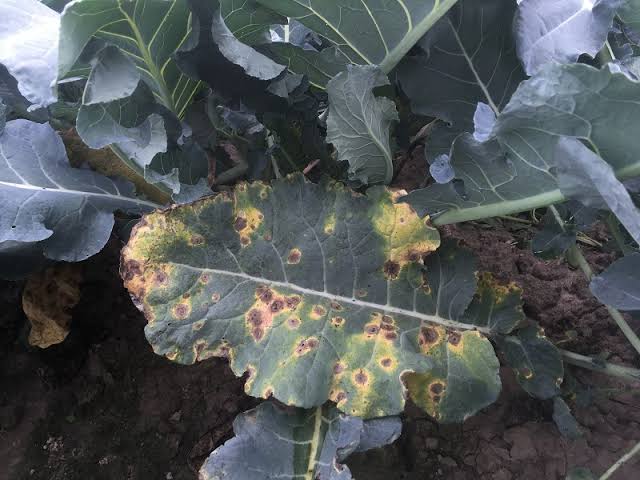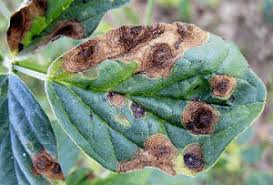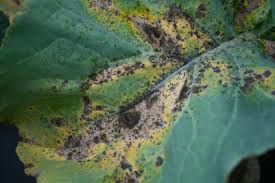Alternaria diseases, scientifically known as alternariosis, are a group of plant diseases caused by fungi belonging to the genus Alternaria. These fungi are widespread and can affect various plants, including crops, ornamental plants, and trees. Alternaria diseases can lead to significant economic losses in agriculture and impact the overall health of plants.
The fungi responsible for Alternaria diseases produce spores that can be dispersed by wind, water, or insects, contributing to the rapid spread of the infection. These spores can survive in soil, plant debris, and on infected plant surfaces, creating a persistent threat to crops and vegetation.
Plants infected with Alternaria diseases often display characteristic symptoms, such as dark lesions, spots, or streaks on leaves, stems, and fruits. These symptoms result from the production of toxic compounds and enzymes by the Alternaria fungi, which cause cell damage and tissue decay. In severe cases, the affected plant parts may wither, leading to reduced yield and quality of crops.
Crop susceptibility to Alternaria diseases varies, but some common targets include tomatoes, potatoes, citrus fruits, cruciferous vegetables, and various grains. The severity of the infection can be influenced by environmental conditions such as humidity, temperature, and plant stress.
Management of Alternaria diseases involves a combination of cultural, chemical, and biological control measures. Crop rotation, proper sanitation, and the use of disease-resistant plant varieties can help mitigate the risk of infection. Fungicides are often employed to control the spread of Alternaria diseases, but their effectiveness can be influenced by factors such as timing, application method, and resistance development.
Despite efforts to manage Alternaria diseases, challenges persist due to the adaptability and resilience of the fungi. Ongoing research aims to develop more sustainable and integrated approaches to disease control, considering the ecological impact and long-term efficacy of different strategies.
Understanding the biology and behavior of Alternaria fungi is crucial for developing effective and sustainable strategies to mitigate the impact of these diseases on crops and vegetation. Continued research and collaboration within the scientific community are essential to address the evolving challenges presented by Alternaria diseases and ensure the resilience of global agriculture.
Read Also: Caterpillars: Description, Damages Caused, Control and Preventive Measures
Plants Affected by Alternaria Diseases

Alternaria diseases can affect a wide range of plants, causing various symptoms and impacting agricultural and horticultural crops. Some notable plants affected by Alternaria diseases include:
1. Tomatoes: Alternaria solani is a common pathogen affecting tomatoes, causing early blight. This disease is characterized by dark lesions on leaves, stems, and fruits, leading to reduced yield and quality.
2. Potatoes: Early blight, caused by Alternaria solani, also affects potatoes. Infected plants exhibit dark spots on leaves, reducing the size and quality of tubers.
3. Citrus Fruits: Citrus crops, including oranges, lemons, and grapefruits, can be susceptible to Alternaria diseases. Symptoms include lesions on leaves and fruit, affecting both the appearance and market value.
4. Cruciferous Vegetables: Crops like cabbage, broccoli, and cauliflower are vulnerable to Alternaria brassicicola, causing dark spots on leaves, leading to defoliation and reduced crop quality.
5. Cucurbits: Alternaria cucumerina affects cucumbers, pumpkins, and other cucurbit plants. It can cause leaf spots and affect fruit quality, impacting the overall yield.
6. Apples: Alternaria mali can infect apple trees, leading to apple Alternaria blotch. This disease manifests as dark spots on leaves and fruit, potentially causing premature fruit drop.
7. Grains: Various grains, including wheat, barley, and oats, can be affected by Alternaria species. Grain crops may show symptoms like leaf spots and reduced grain quality.
8. Ornamental Plants: Alternaria diseases can also impact ornamental plants such as roses, causing leaf spots and affecting the aesthetic appeal of the plants.
It’s important for growers and gardeners to be aware of the susceptibility of different plant species to Alternaria diseases and implement preventive measures to minimize the impact on crop yield and quality. Integrated disease management practices, including crop rotation, resistant varieties, and timely fungicide applications, play a crucial role in mitigating the effects of Alternaria diseases on various plants.
Damages Caused by Alternaria Diseases

Alternaria diseases can inflict significant damage on affected plants, leading to economic losses in agriculture and horticulture. The damages caused by Alternaria diseases include:
1. Reduced Yield: One of the primary consequences of Alternaria diseases is a reduction in crop yield. The fungi can affect the photosynthetic capacity of leaves, leading to premature leaf drop and decreased production of fruits, vegetables, or grains.
2. Quality Degradation: Alternaria diseases often result in a decline in the quality of harvested produce. Fruits and vegetables may develop dark spots, lesions, or discoloration, making them less appealing to consumers. This can lead to market rejection and lower prices for affected crops.
3. Premature Defoliation: Infected plants commonly experience premature defoliation, where leaves wither and drop before reaching their full growth potential. This weakens the plant, reducing its ability to produce energy through photosynthesis.
4. Post-Harvest Losses: Alternaria diseases can continue to affect crops even after harvest. Fungi may produce spores on stored produce, leading to post-harvest losses as the pathogens spread and cause decay during storage and transportation.
5. Impact on Ornamental Plants: In the case of ornamental plants, Alternaria diseases can compromise the visual appeal of flowers and foliage. Dark spots and lesions on leaves diminish the aesthetic value of ornamental plants, affecting landscaping and horticultural industries.
6. Decreased Crop Resilience: Plants weakened by Alternaria diseases become more susceptible to other stress factors, such as adverse weather conditions, pests, and additional diseases. This decreased resilience can create a domino effect, further compromising overall crop health.
7. Increased Production Costs: Controlling Alternaria diseases often requires the application of fungicides and other management practices, leading to increased production costs for farmers. These costs, coupled with the potential loss of yield and quality, contribute to the economic impact of Alternaria diseases.
8. Challenges in Storage: For crops intended for storage, such as grains and tubers, Alternaria diseases can pose challenges. Fungi may produce mycotoxins that affect the storage quality of grains and can be harmful if consumed by humans or animals.
Understanding the damages caused by Alternaria diseases is crucial for developing effective strategies to manage and mitigate their impact on agriculture and horticulture. Integrated disease management approaches that encompass cultural, chemical, and biological control methods play a key role in minimizing these damages and ensuring the sustainability of crop production.
Read Also: Sawflies: Description, Damages Caused, Control and Preventive Measures
Control and Preventive Measures

Implementing effective control and preventive measures is crucial in managing Alternaria diseases and minimizing their impact on crops. Some key strategies include:
1. Crop Rotation: Rotate crops to disrupt the disease cycle. Avoid planting susceptible crops in the same location consecutively, as this reduces the buildup of Alternaria spores in the soil.
2. Resistant Varieties: Use plant varieties that are resistant or less susceptible to Alternaria diseases. Breeding and selecting resistant cultivars can be an effective long-term strategy to reduce the risk of infection.
3. Sanitation Practices: Remove and destroy infected plant debris promptly. This reduces the potential for Alternaria spores to survive and spread. Proper sanitation also includes cleaning equipment and tools to prevent inadvertent transmission of the pathogen.
4. Proper Water Management: Avoid overwatering, as excess moisture creates a favorable environment for Alternaria diseases. Use drip irrigation or water at the base of plants to minimize leaf wetness and reduce the risk of fungal growth.
5. Air Circulation: Ensure adequate spacing between plants to promote air circulation. Good air movement helps to reduce humidity around plant leaves, creating an unfavorable environment for Alternaria spore germination and infection.
6. Fungicide Applications: Consider applying fungicides as a part of an integrated disease management strategy. Fungicides containing active ingredients effective against Alternaria can be applied preventively or in response to early signs of infection. Follow recommended application rates and schedules.
7. Biological Control: Explore the use of biological control agents, such as beneficial microbes or antagonistic fungi, to suppress Alternaria diseases. Biological control methods can offer sustainable and environmentally friendly alternatives to chemical treatments.
8. Timely Harvesting: Harvest crops at the appropriate time to minimize the risk of post-harvest infections. Prompt harvesting prevents the accumulation of spores on mature fruits or vegetables.
9. Monitoring and Early Detection: Regularly inspect plants for signs of Alternaria diseases. Early detection allows for timely intervention, reducing the severity of the infection. Train farmers and growers to recognize symptoms and take action promptly.
10. Weather Monitoring: Be aware of weather conditions that favor Alternaria diseases, such as high humidity and warm temperatures. Adjust management practices accordingly during periods conducive to disease development.
By combining these control and preventive measures, growers can develop a holistic approach to managing Alternaria diseases. Integrated strategies that incorporate multiple methods contribute to more sustainable and effective disease control, ultimately preserving crop yield and quality.
Frequently Asked Questions (FAQs) About Alternaria Diseases (alternariosis)
1. Q: What are Alternaria diseases?
A: Alternaria diseases refer to a group of plant diseases caused by fungi from the Alternaria genus. These diseases affect various plants, leading to symptoms such as dark lesions, spots, and streaks on leaves, stems, and fruits.
2. Q: Which plants are commonly affected by Alternaria diseases?
A: Alternaria diseases can impact a wide range of plants, including tomatoes, potatoes, citrus fruits, cruciferous vegetables, cucurbits, apples, grains, and ornamental plants.
3. Q: How do I recognize Alternaria diseases on my plants?
A: Look for dark lesions, spots, or streaks on leaves, stems, and fruits. Infected plants may exhibit premature defoliation, and the overall appearance may be affected. Early detection is essential for effective management.
4. Q: What causes Alternaria diseases to spread?
A: Alternaria fungi produce spores that can be dispersed by wind, water, or insects. Spores can survive in soil, plant debris, and on infected surfaces, contributing to the rapid spread of the diseases.
5. Q: How can I prevent Alternaria diseases in my garden or farm?
A: Preventive measures include crop rotation, using resistant plant varieties, practicing good sanitation, managing water carefully, ensuring air circulation, and monitoring for early signs of infection. These strategies collectively help reduce the risk of Alternaria diseases.
6. Q: Can Alternaria diseases be controlled with fungicides?
A: Yes, fungicides containing active ingredients effective against Alternaria can be used as part of an integrated disease management strategy. Proper application timing and following recommended rates are crucial for effectiveness.
7. Q: Are there organic or biological methods to control Alternaria diseases?
A: Yes, biological control methods, such as the use of beneficial microbes or antagonistic fungi, can be explored. Additionally, organic practices like crop rotation and careful management of soil health contribute to disease prevention.
8. Q: How do Alternaria diseases impact crop yield and quality?
A: Alternaria diseases can lead to reduced yield, premature defoliation, and decreased quality of harvested produce. Fruits and vegetables may develop dark spots, lesions, or discoloration, affecting market value.
9. Q: Can Alternaria diseases affect stored grains?
A: Yes, Alternaria diseases can pose challenges in stored grains. Fungi may produce mycotoxins that affect grain quality, potentially causing post-harvest losses.
10. Q: Is there ongoing research on Alternaria diseases?
A: Yes, ongoing research aims to develop sustainable and integrated approaches to control Alternaria diseases. Scientists are investigating new methods, including resistant cultivars and environmentally friendly biological control agents.
